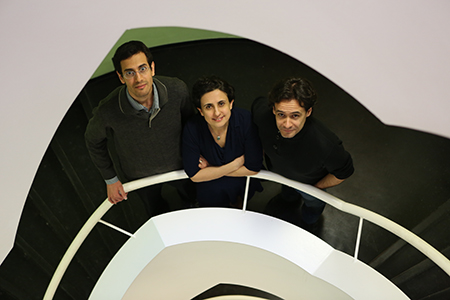Thanks to the work of researchers at the Interdisciplinary Centre for Security, Reliability and Trust, companies developing satellites, cars and other Cyber-Physical Systems, are one-step closer to testing these complex machines efficiently in simulation. In recognition of this achievement, Dr. Carlos A. González, Mojtaba Varmazyar, Dr. Shiva Nejati and Prof. Lionel C. Briand received a Best Paper Award at a recent ACM/IEEE-sponsored software engineering conference in Denmark.
In Cyber-Physical Systems such as satellites, dozens of embedded computers interact to control physical processes and react to the environment. Engineers can’t wait until the satellite has been built, or even until all the components are known, to test these intricate systems. Instead, they must identify problems early on by running simulations on computer models of the software, hardware and environment. No one modelling language, however, can cover all of these aspects. The SnT researchers therefore devised a co-simulation framework to allow engineers to execute the different models in in an integrated way.
“Engineers use one modelling language to simulate the hardware and environment behaviour of a complex cyber physical system. But, to account for software behaviours in their simulations, they have to then recreate the entire system in another language,” says Dr. Shiva Nejati. “Our framework allows engineers to test software, algorithmic and physical aspects of the system at the same time without the need to recreate the entire system in multiple languages. This saves time and helps identify problems earlier in the development process”.

L-R: Mojtaba Varmazyar, Dr. Shiva Nejati and Dr. Carlos A. González
The work was carried out in close collaboration with Yago Isasi, Head of Software at SnT industry partner LuxSpace, a leading provider of micro satellites and aerospace systems. “Isasi and his team spent a lot of time with us, allowing us to ensure that our work was relevant and that our solutions would work in practice,” continues Nejati. “All of the existing co-simulation frameworks out there fall down in some way when it comes to real-world usage. For example, in addition to supporting multiple modelling languages, the framework needs to be able to run thousands of simulations overnight and without user intervention, and to present meaningful data about correctness or failure of simulation results.”
The paper presenting their work, ‘Enabling Model Testing of Cyber-Physical Systems‘ won the Practice and Innovation track Best Paper Award at the ACM/IEEE 21st International Conference on Model Driven Engineering Languages and Systems, Denmark, in October. It forms part of Prof. Briand’s on-going project, Testing the Untestable, funded by an ERC Advanced Grant, the most prestigious research award in Europe.
